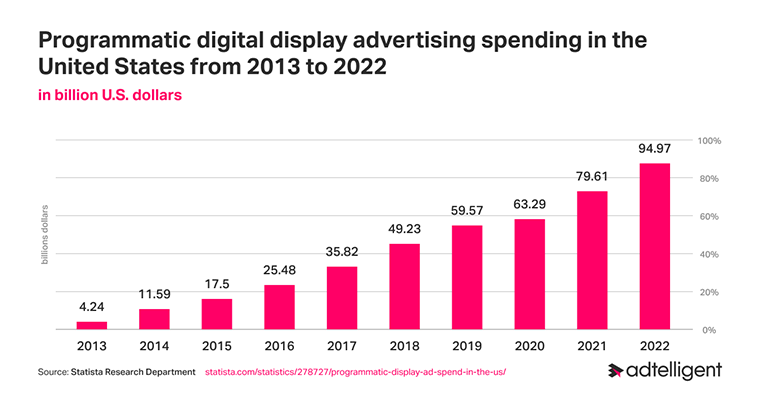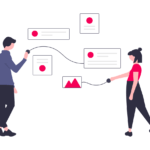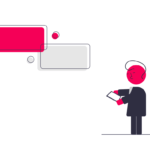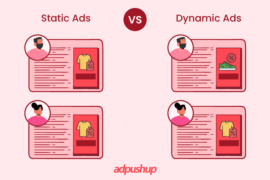Explore the key differences between direct deals and programmatic deals in advertising, including pricing, level of control, and the role of automation. Find out which approach may be best for your advertising needs.
Ad technology enables publishers to sell their inventory via direct deals, real-time bidding, private auction, programmatic guaranteed, and many more. As the list of options increases, publishers wonder—which method is the most profitable for selling their ad inventory?
One way to find out is A/B testing. Ad testing helps publishers choose between different ad placements, layouts, and types. However, things become complicated when it comes to choosing between direct deals and programmatic deals. This is because of the difference in how they are executed.
Programmatic deals are completely automated, while direct deals involve human involvement. Due to this, they are difficult to compare.
Although programmatic deals have existed since 1994, they gained significant prominence and relevance in 2007. Programmatic deals in deals programmatic advertising have come a long way. Now the numbers may leave you awestruck.
Programmatic display ads alone have gained enormous traction. Take a look:

Now, without further ado, let’s delve into the direct and programmatic deals nitty-gritty and understand the difference between the two.
Also Read – What is Programmatic Direct: All You Need to Know
Let’s start with a quick introduction to both.
Direct Deals
The process of selling the publisher’s ad inventory directly to the advertiser. Sometimes a negotiator or agency initiates contact between the publisher and the advertiser. With a direct deal, no auction is conducted; instead, the inventory is sold at a fixed price.
Programmatic Deals
The automated sale and purchase of ad inventory. An auction is conducted as soon as an impression is available (except in the case of Programmatic Guaranteed where no auction is involved), and a buyer is determined. Programmatic deals rely on complex auction algorithms and minimal human intervention. Programmatic makes use of OpenRTB Protocol and is transacted on an impression level.
Confusion Clarified: What is programmatic direct?
Programmatic direct represents a fusion of traditional direct deals and programmatic buying in the realm of digital advertising. Traditionally, purchasing ad space involved negotiating fixed prices directly with publishers and managing ad insertion manually. Conversely, programmatic buying employs automation and real-time bidding to efficiently secure ad spots across various platforms, enabling targeted audience engagement. Programmatic direct seamlessly integrates these methodologies. Advertisers engage in direct negotiations with publishers for premium ad space, yet the process is automated through programmatic platforms like Demand-side Platforms (DSPs). This approach affords advertisers the desired control and targeting capabilities while simplifying the purchasing process.
The advantages of programmatic direct are manifold. For publishers, it ensures premium ad inventory is filled at higher prices, optimizing revenue streams. Advertisers benefit from guaranteed access to targeted audiences on reputable websites, enhancing campaign effectiveness. Ultimately, programmatic direct represents a mutually beneficial solution for advertisers and publishers alike, offering an efficient and effective means of transacting digital ad space.
How Do They Work?
As mentioned, programmatic deals are automated. When a user lands on a publisher’s site and is ready to be served an impression, a bid request is generated, which contains the details of the user’s parameters (history, demographics, behavior) for targeting purposes. Publisher’s SSP then sends this bid request to the connected ad exchange to find a suitable creative for the user.
Based on the user’s information, the ad exchange further passes the signal to the demand-side platforms (DSP). Different DSPs send their buyer bids back to the ad exchange. The ad exchange then conducts the auction and selects the winning creative. The publisher’s site retrieves the ad creative from the ad server and shows it on the user’s screen.
In case of direct deals, publishers are either directly contacted by the advertiser or an agency connects them; following this, publishers send a request for proposal (RFP). No matter how connected, the publisher and advertiser communicate directly to discuss the terms. After negotiating the price, an insertion order is signed by both parties. Depending on the terms, the advertiser gets to display his creatives on the publisher’s site for a fixed price and time interval.
Also Read – The Four Types of Programmatic Deals (2023 Update)
Difference Between Direct Deals & Programmatic Deals
There are plenty of differences both these methods share; let’s understand a few of them.
| Programmatic Deals | Direct Deals | |
| Automation Level | Fully automated | Manual |
| Ad Inventory | Remnant inventory | Premium inventory |
| Pricing | Auction-based pricing | Fixed pricing |
| Targeting | Audience-based targeting | Contextual targeting |
Let’s have a closer look and shine some light on major differences.
Price
In direct deals, the prices of direct deals have already been set forth by the publishers, whereas in programmatic deals, advertisers have to participate in the RTB auctions. In programmatic deals, the advertiser who pays the highest bid gets to showcase their ads. The common question in many’s minds is how much money that ad slot can make.
There’s no fixed number or limit on how much that ad slot will earn.
It’s important to remember that the cost per thousand impressions (CPM) rate for direct advertising sales is typically higher than the effective cost per thousand impressions (eCPMs) achieved through programmatic methods. However, when assessing the profitability of different monetization strategies, we need to consider the overall revenue generated by the entire website rather than just a single ad unit’s rate.
Efforts
As an advertiser, when you choose to work with an ad network that you trust, you rest assured that you will be provided with the best possible SSPs. The ad network will do the legwork, ensuring everything matches your target audience, market, industry, etc.
On the other hand, when you choose to personally work with an advertiser or opt for a direct deal, there are quite a few activities you’ll need to perform with a close eye. From singling out the right advertisers to getting into the nitty-gritty details of what creatives should be posted, in what quantities, etc, there’ll be many things to do on your plate.
Control
Another major difference that programmatic direct and direct deals share is the level of control publishers have over their inventory. With programmatic direct, publishers can exert more control over their inventory, setting certain rules and parameters for selling it. In contrast, direct deals may give advertisers more control over how their ads are displayed, potentially limiting the publisher’s ability to control the user experience on their site.
Advantages & Disadvantages of Programmatic and Direct Media Buying
Programmatic and direct media buying each offer distinct advantages and disadvantages in the realm of digital advertising.
Advantages of Programmatic Buying:
1. Efficiency: Programmatic buying automates the process of purchasing ad space, saving time and resources compared to manual methods.
2. Targeting Capabilities: It allows for precise audience targeting based on various data points, improving the relevance and effectiveness of ads.
3. Real-time Optimization: Programmatic platforms enable advertisers to adjust campaigns in real-time based on performance metrics, maximizing ROI.
4. Access to Inventory: Advertisers gain access to a vast array of ad inventory across multiple publishers and platforms, increasing reach and visibility.
5. Cost-effectiveness: Real-time bidding mechanisms ensure advertisers pay competitive prices for ad placements, potentially lowering overall advertising costs.
Disadvantages of Programmatic Buying:
1. Complexity: The intricacies of programmatic buying, including data analysis and bidding strategies, can be challenging for inexperienced advertisers to navigate.
2. Fraud and Brand Safety Concerns: Automated processes may expose advertisers to risks such as ad fraud and placement on inappropriate or low-quality websites.
3. Lack of Transparency: Advertisers may have limited visibility into where their ads are placed and how their budget is allocated within programmatic ecosystems.
4. Ad Blocking: Programmatic ads may be more susceptible to ad blockers, reducing their effectiveness in reaching target audiences.
5. Dependence on Technology: Technical issues or glitches within programmatic platforms can disrupt campaign performance and require immediate troubleshooting.
Advantages of Direct Media Buying:
1. Control and Transparency: Direct media buying allows advertisers to negotiate directly with publishers, offering greater control over ad placements and ensuring transparency in pricing and placement.
2. Premium Inventory: Advertisers can secure prime ad placements on high-quality websites, maximizing visibility and brand association.
3. Relationship Building: Direct buying fosters relationships between advertisers and publishers, potentially leading to long-term partnerships and favorable terms.
4. Brand Safety: Advertisers have more control over where their ads appear, reducing the risk of association with inappropriate or harmful content.
5. Creative Flexibility: Direct buying enables advertisers to collaborate closely with publishers on ad creatives, optimizing messaging and design for target audiences.
Disadvantages of Direct Media Buying:
1. Manual Processes: Direct buying typically involves manual negotiations and ad placements, which can be time-consuming and resource-intensive.
2. Limited Reach: Advertisers may have access to a narrower range of inventory compared to programmatic buying, potentially limiting campaign reach.
3. Higher Costs: Premium ad placements secured through direct buying may come at a higher cost compared to programmatic bidding.
4. Lack of Real-time Optimization: Unlike programmatic buying, direct buying lacks the agility to adjust campaigns in real-time based on performance data.
5. Targeting Limitations: Direct buying may offer less granular audience targeting options compared to programmatic platforms, limiting campaign effectiveness in reaching specific audience segments.
Considerations For The Future Of Programmatic
Looking towards the future of programmatic deals in advertising, several key considerations emerge that are poised to shape the landscape. Firstly, there’s a heightened emphasis on brand safety and transparency, driven by ongoing concerns surrounding ad fraud and the need for advertisers to maintain alignment with their brand values. Demand for premium, brand-safe inventory will fuel the development of technologies and partnerships focused on ensuring ads are placed in suitable environments. Additionally, as data privacy regulations like GDPR and CCPA evolve, programmatic deals must adapt to prioritize user consent and compliance while still enabling effective targeting and personalization.
Secondly, there’s a discernible shift towards prioritizing quality over quantity in programmatic transactions. Advertisers are increasingly seeking meaningful indicators of engagement and ROI, moving away from traditional metrics like impressions and clicks. This shift underscores the importance of programmatic deals that deliver measurable outcomes such as viewability, engagement rates, and attribution. Consequently, private marketplaces and programmatic guaranteed deals are gaining traction, offering advertisers access to premium inventory while affording publishers greater control over pricing and placements.
Lastly, the future of programmatic deals will be characterized by the adoption of emerging technologies and the evolution of cross-channel and cross-device strategies. Artificial intelligence, machine learning, and blockchain are poised to play pivotal roles in driving efficiencies and improving outcomes within programmatic environments. Meanwhile, advertisers will increasingly embrace cross-channel and cross-device strategies to engage consumers seamlessly across desktop, mobile, social, and emerging channels. Adapting to these considerations will be crucial for advertisers and publishers alike to remain competitive and successful in the evolving landscape of programmatic advertising.
Which Deal Generates More Money for Publishers?
Direct deals. Generally, publishers only put their premium inventory up for direct deals. And due to better CTR and conversions, advertisers generally agree to pay higher prices. On the other hand, with programmatic deals like PMPs and RTBs, there is no guarantee of how much money a publisher might make (depending on the number of impressions the advertiser is willing to buy). Also, some ad units may even get blank impressions due to low fill rates, creating further uncertainty in yield.
Which One Offers Better Targeting?
Both methods offer to target options to the advertisers.
With programmatic deals, advertisers buy the audience. They target each user based on demographics, geographical location, and other aspects. Most publishers allow cookie syncing to let advertisers target users in order to get a better click-through rate.
With direct deals, advertisers are generally hoping for contextual targeting. They target the website here rather than the audience.
This is because it is usually predetermined that users visiting the website are more likely to show interest in the ads, based on the existing content on the website.
Let’s understand it with the help of an example:
A lifestyle blogger writing about food, travel, fashion, and other everyday stories wants to sell her inventory. She has a blog page where she uploads all her content related to the mentioned categories. However, she has also categorized food blogs under a specific category. For the rest of her blogs, she runs a programmatic auction. However, she will look for direct deals for the food category blog. A ready-to-eat food brand can contact her. This brand knows that people visiting this particular section of the site are potential food enthusiasts and might also want to try the brand for easy food access. So, the lifestyle blogger can benefit from direct deals and programmatic selling.
Impact of third-party cookie demise
While at the present time, programmatic deals offer more targeting options than direct deals, the situation may very likely change in the coming months. The rapidly approaching demise of third-party cookies will heavily impact how publishers and advertisers have leveraged user data to serve relevant ads.
The tide will inevitably shift towards contextual advertising in the absence of cookies, thereby lending direct deals an upper hand. Google’s Privacy Sandbox is one the alternatives to third-party cookies, and it’s APIs, such as TURTLEDOVE and PARRROT, rely greatly on context-based advertising. Therefore, publishers may benefit widely from leveraging direct deals.
You can also checkout our webinar to know how programmatic is evolving
What About the Workflow?
Direct deals are mostly manual, from finding the buyer or seller and negotiating a deal to placing the creative on the site; everything involves human intervention (the only exception being programmatic guaranteed). It can take weeks to find and negotiate a direct deal. The one-on-one meetings, exchange of emails, and finally, signing an insertion order can all make workflow messy and troublesome. Not to mention, this can involve hiring a sales team for negotiation purposes.
In contrast, programmatic deals are handled by algorithms. Neither much manual input is required nor constant communication between buyer and seller to close a deal. Furthermore, programmatic makes bulk selling of inventory fast and effective. As a result, programmatic deals are much more efficient in ad serving and generating reports simultaneously.
Let’s Talk About Safety
Ad fraud can occur in many ways in the programmatic advertising ecosystem. From domain spoofing to ad stacking, hackers are invading publishers’ website is many different shapes and forms. According to The Drum, so far ad fraud has consumed $80 in 2022, and the number is expected to grow to $100 in 2023.
It would be wrong to blame the entire programmatic structure for ad fraud. Although, if we compare the two, direct deals are safer than programmatic ones. This is because direct deals are negotiated without involving any third party, ensuring privacy. Further, user data doesn’t get shared by anyone but remains with publishers.
Even within programmatic deals, the market is more inclined towards the private marketplace than the open one. It has been predicted that in the coming years, open marketplace spending will be surpassed by private marketplace and one of the reasons for the same is less ad fraud.
In Closing
Both programmatic and direct deals have their pros and cons. Hence, publishers are recommended to implement both methods to maximize their revenues. Place your premium inventory for direct deals and use programmatic deals to sell unsold inventory.
Programmatic is all about machines and software, working to sell/purchase inventory with the least human involvement. In programmatic deals, the price and ad creatives are chosen dynamically, making it uncertain for publishers to predict the profit. However, the previous performance of the inventory can help anticipate a number.
Direct deals involve human involvement with negotiation and manual IO creation. It is recommended to choose direct deals for premium inventory to maximize profit. Due to its pre-negotiated nature, the price remains unchanged throughout the campaign, eliminating revenue uncertainty.
FAQs – Direct Deals
To put it in a simple way, it refers to an advertising agreement between a publisher and an advertiser. In this agreement, advertisers purchase a publisher’s ad inventory directly from the publisher at a pre-decided amount.
Direct deals are negotiated and agreed upon directly between the advertiser and publisher, while programmatic advertising uses automated technology to purchase ad inventory in real time through an ad exchange.
Direct deals can be used for a plethora of ad formats. It includes display ads, video ads, native ads, and more, depending on the publisher’s and advertiser’s capabilities and preferences.











1 Comment
Great post.